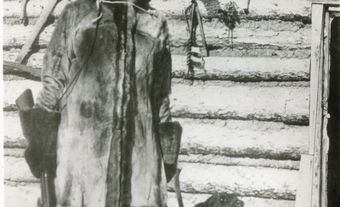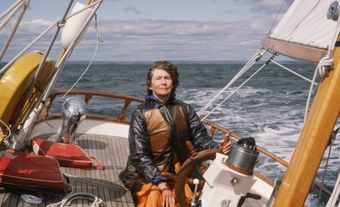Mary Morris Vaux Walcott, botanical artist, photographer, glaciologist, mountaineer (born 31 July 1860 in Philadelphia, Pennsylvania; died 22 August 1940 in Saint Andrews, NB). For over 40 years, Vaux Walcott spent nearly every summer in the Canadian Rockies, where she and her brothers conducted some of the first studies of glaciers in Canada. She also became the first woman in Canada to summit a peak over 3,000 m. An avid and accomplished botanical artist, Vaux Walcott’s crowning achievement was the publication of 400 of her watercolours in the five-volume North American Wild Flowers.

Early Life
Mary Morris Vaux was born into a wealthy and prominent Quaker family in Philadelphia, Pennsylvania on 31 July 1860. The eldest of three children, Vaux Walcott’s two younger brothers were George Jr. and William. Although the Quaker community valued the pursuit of knowledge and afforded women a relative degree of equality, she did not have the opportunity to attend university. Vaux Walcott’s mother died soon after she graduated from the Friends Select School in Philadelphia. As the only daughter in the family, she became responsible for looking after her father and brothers, managing the household and working on the family’s dairy farm.
Trips to the Canadian Rockies
The Vaux family first visited the Canadian Rockies in 1887, on a summer holiday on the newly opened Canadian Pacific Railway (CPR). They stopped at the Glacier House Hotel in the Selkirk Mountains and became enamored with the region. When the family finally returned to the area seven years later, they noticed that the Illecillewaet Glacier they had visited during their first trip had visibly receded. Because of this, the siblings embarked on a decades-long mission of documenting the changing glaciers in drawings, maps, surveys and photographs, returning to the area every summer. Their work constitutes some of the earliest glacial research in Canada.
The Vaux siblings took around 2,500 photos of the peaks and glaciers of the Rockies. Vaux Walcott became a proficient photographer and was responsible for developing their photos. Their photographs were exhibited and used in CPR pamphlets. Because she was a woman, Vaux Walcott’s exhibited drawings and photographs were credited only with her surname.
After her youngest brother William’s death in 1908 and due to George Jr.’s increasing commitments in Philadelphia, Vaux Walcott continued the family’s glacial studies by herself. George Jr. and her father occasionally accompanied her on these trips, but she typically returned alone.
Of course golf is a fine game, but can it compare with a day on the trail, or a scramble over the glacier, or even with a quiet day in camp to get things in order for the morrow’s conquest? Some how when once this wild spirit enters the blood, golf courses and hotel piazzas, be they ever so brilliant, have no charm, and I can hardly wait to be off again.
─ Mary Vaux Walcott
Mountaineering
The Vaux family developed an interest in mountaineering during their time spent in the Rockies. The siblings were founding members of the Alpine Club of Canada and members of the American Alpine Club. Vaux Walcott became the first woman in Canada to summit a peak over 3,000 m when she ascended Mount Stephen in British Columbia in 1900. Mount Mary Vaux, a 3,208 m peak in Jasper National Park, was named in her honour by her friend and fellow naturalist, Mary Schäffer Warren.
Botanical Artwork
Mary Vaux Walcott received her first set of watercolour paints at age eight. As art was only acceptable within the Quaker community when in the pursuit of science, she used nature as her subject. During her annual trips to the Rockies, she sketched and painted the wildflowers she encountered, many in hard to reach places.
The paintings she completed over 25 years became the basis of her greatest accomplishment: a five-volume illustrated book titled North American Wild Flowers. Published by the Smithsonian Institution between 1925 and 1929, the series featured 400 of her botanic watercolours. The book took four years to make and cost $750,000 USD — the equivalent of over $12.5 million USD today. The innovative and intensive printing technique used to reproduce Vaux Walcott’s coloured paintings contributed to the cost. The book used heavy rag paper, which prevented the colours from fading over time. The paintings were reproduced using layers of waterproof ink, with each layer being applied before the previous had fully dried. Finally, the pages were dipped in water and hand dried. The resulting reproductions were nearly identical to the original watercolours. A total of 2,500 sets of the book were produced, with each volume selling for up to $500 USD.
Vaux Walcott received critical acclaim for the book for her elegant and accurate paintings and its innovation at the time. She was nicknamed the "Audubon of Botany," a reference to John James Audubon’s The Birds of America, an ambitious 19th-century publication of life-sized watercolours of birds. Her book became a staple for the identification of wildflowers. In 1935, she published another collection of her paintings in Illustrations of North American Pitcher-Plants.
Marriage and Later Life
On a trip to the Rockies in 1913, at the age of 53, Mary Vaux met Charles D. Walcott, secretary of the Smithsonian Institution. Charles was the leading authority on Cambrian Era paleontology and had discovered the Burgess Shale fossils in the Rockies. The couple bonded over their shared interests and married the following year. They lived in Washington, DC, but returned to the Rockies for several months every summer.
After Charles’ death in 1927, Vaux Walcott continued visiting the Rockies annually until 1939. She also continued to travel throughout Canada and the United States. In 1927, American president Calvin Coolidge appointed her to serve on the federal Board of Indian Commissioners and she spent five years touring and studying the living conditions of Indian reservations in the United States. In 1931, she became the first woman to speak at the Royal Canadian Institute when she gave a presentation on the wildflowers of the Rockies. She was active in various organizations, such as the Society of Women Geographers, the American Association for the Advancement of Science and the Academy of Natural Sciences.
Vaux Walcott died on 22 August 1940 in Saint Andrews, New Brunswick, while on a trip to visit friends in Nova Scotia. In 2022, the Smithsonian Gardens named an orchid hybrid, the x Rhyncattleanthe Mary Vaux Walcott, in her honour.

 Share on Facebook
Share on Facebook Share on X
Share on X Share by Email
Share by Email Share on Google Classroom
Share on Google Classroom






